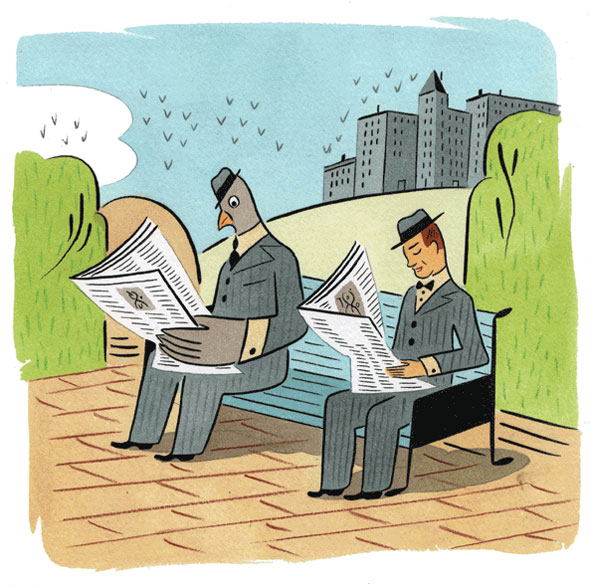city living
Fowl Friends
sociologist explores the love-hate relationship between people and pigeons
by Eileen Reynolds / GSAS ’11
As anyone who’s ever shooed a bird from a bench knows, pigeons are an urban dweller’s constant companions: They roost on our air-conditioners, scavenge our sidewalks, and leave their feathery waste on our monuments. Mostly, we just watch them and try to steer clear.
Fascinated by this human-avian dance, sociology and environmental studies professor Colin Jerolmack embarked on four years of research that ultimately took him to the iconic public squares of London and Venice, and even as far away as South Africa, home to the annual Million Dollar Pigeon Race. But some of the most compelling findings reported in his new book, The Global Pigeon (University of Chicago Press), grew out of countless hours spent right here in New York, where Jerolmack gazed up at the skies with members of the Bronx Homing Pigeon Club, hung out with a group of working-class Brooklynites brought together by the pigeons they breed, and watched scrappy Greenwich Village birds beg for pizza crusts in the neighborhood’s tiny public parks.
NYU Alumni Magazine caught up with Jerolmack to talk about the city’s much-maligned birds, the people who love and feed them, and why the "rats with wings" moniker—first coined in 1966 by pigeon-hating city parks commissioner Thomas P.F. Hoving—is just unfair.
“There’s no documented case of a person getting sick from a street pigeon,” Jerolmack says.
You observed that pigeons are pretty crafty about getting New Yorkers to toss them scraps.
How do they do it?
Pigeons are synanthropes—animals that adapt and actually do better in human-disrupted environments
than they did in the natural habitat. They’re rewarded when they walk close to people, cock
their head, double back—they have strategies to evoke feeding from people who just came to a park
to eat a pizza and talk with their friend.
The book looks at unlikely friendships forged over rooftop pigeon coops in Brooklyn. How did
that come about?
It’s based on a very pragmatic problem. Pigeon flying is a lot of work. Hopefully your son
helps you [to] clean the coop, bring the 50-pound sacks of feed, train the pigeons when
you’re at work. But if you can’t get your son, you hire a neighborhood kid. For the
older [Italian-Americans] who stayed behind in Bushwick as the neighborhood changed, the only
kids available were Puerto Rican and black. And some of these kids became fascinated—what
started as a job to make some side money became their own interest. Now they’re all adults,
and they’re bound together by these birds. In neighborhoods like Bushwick and Bed-Stuy,
through this fascination with the birds, these men form neighborhood and community ties that
transcend racial barriers. It’s definitely a New York story.
For a city slicker, what’s appealing about racing homing pigeons?
When you send your pigeon out for 400 miles, it has to traverse hostile terrain. There are hawks;
there are storms they have to go around; not all of them will make it home. When that bird comes
back over the horizon, there’s this tremendous rush: Here’s this treasure that you bred
and willfully surrendered, not knowing if you’d ever see it again, coming back to you. In
a way, even if you didn’t win the race, nurture has triumphed over nature. You’ve
figured out how to manipulate both the bird’s genes and behavior to outfox the storms,
the weather, the hawks.
Why do pigeons have such a bad reputation? Is it true they can make us sick?
Do pigeons carry disease? Yes. But there’s a difference between diseases they can transmit
to other pigeons and diseases they can transmit to people. West Nile? They’re resistant. Bird
flu? They mostly don’t get it, and if they do get it, they die immediately, which means they
aren’t a good carrier. There’s no documented case of a person getting sick from a
street pigeon. That doesn’t mean you should be happy about pigeon feces on a bench, but
let’s put it in perspective. The whole disease thing is a red herring. It’s an excuse.
It’s a frame that allows us to justify getting rid of animals that we don’t like
anyway.







